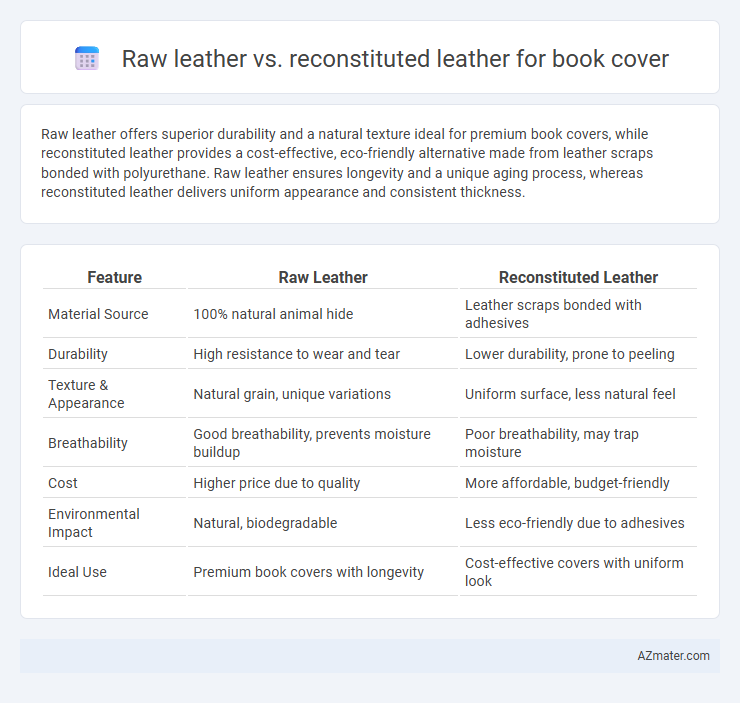Raw leather offers superior durability and a natural texture ideal for premium book covers, while reconstituted leather provides a cost-effective, eco-friendly alternative made from leather scraps bonded with polyurethane. Raw leather ensures longevity and a unique aging process, whereas reconstituted leather delivers uniform appearance and consistent thickness.
Table of Comparison
| Feature | Raw Leather | Reconstituted Leather |
|---|---|---|
| Material Source | 100% natural animal hide | Leather scraps bonded with adhesives |
| Durability | High resistance to wear and tear | Lower durability, prone to peeling |
| Texture & Appearance | Natural grain, unique variations | Uniform surface, less natural feel |
| Breathability | Good breathability, prevents moisture buildup | Poor breathability, may trap moisture |
| Cost | Higher price due to quality | More affordable, budget-friendly |
| Environmental Impact | Natural, biodegradable | Less eco-friendly due to adhesives |
| Ideal Use | Premium book covers with longevity | Cost-effective covers with uniform look |
Introduction to Raw Leather and Reconstituted Leather
Raw leather, also known as full-grain leather, is crafted from the top layer of animal hide, preserving natural textures and durability, making it ideal for premium book covers. Reconstituted leather, made from shredded leather scraps bonded with polyurethane or latex, offers a more affordable, uniform alternative with less breathability and longevity. Understanding these fundamental differences helps in selecting the appropriate material based on durability, appearance, and cost for book cover applications.
Defining Raw Leather: Characteristics and Types
Raw leather, also known as full-grain leather, is derived directly from animal hides, preserving the natural grain and imperfections that contribute to its durability and unique texture. This type of leather includes variations such as top-grain and nubuck, each offering distinct tactile qualities and levels of finish appropriate for premium book covers seeking longevity and authentic aesthetics. Raw leather's breathability and resistance to wear make it a preferred material for high-quality bookbinding where preservation and tactile appeal are essential.
What is Reconstituted Leather? Composition and Features
Reconstituted leather, also known as bonded leather, is made from shredded genuine leather scraps combined with polyurethane and a fabric backing, forming a composite material. This composition offers an economical alternative to raw leather with a consistent texture and appearance, though it lacks the durability and breathability of full-grain or top-grain leather. Common features of reconstituted leather include its smooth finish, uniform color, and resistance to cracking, making it suitable for decorative book covers while providing cost efficiency.
Visual and Textural Differences in Book Covers
Raw leather book covers showcase a natural grain pattern with unique scars and wrinkles, offering a rich texture and genuine organic feel that ages beautifully over time. Reconstituted leather covers present a uniform appearance with consistent color and texture, lacking the individual markings found in raw leather and often feeling smoother but less breathable. The visual depth and tactile complexity of raw leather contribute to a premium, artisanal impression, while reconstituted leather provides a cost-effective alternative with predictable aesthetics.
Durability Showdown: Raw vs Reconstituted Leather
Raw leather offers superior durability for book covers due to its natural grain structure and resistance to wear, making it ideal for long-lasting protection. Reconstituted leather, composed of leather fibers bonded with adhesives, tends to be less durable and more prone to cracking or peeling over time. Choosing raw leather ensures enhanced longevity and resilience against frequent handling and environmental factors.
Cost Comparison for Publishers and Collectors
Raw leather book covers offer premium durability and aesthetic appeal but come with significantly higher costs, ranging from $30 to $60 per cover, impacting publishers' budgets and collectors' investments. Reconstituted leather, made from shredded leather fibers combined with polyurethane, reduces expenses to approximately $10 to $20 per cover, appealing to cost-conscious publishers and collectors seeking affordable yet stylish alternatives. While raw leather increases overall production value and resale price, reconstituted leather provides a budget-friendly option with lower material and maintenance costs.
Eco-Friendliness and Sustainability Factors
Raw leather, derived from untreated animal hides, involves intensive resource consumption and environmental pollution during tanning, making it less eco-friendly for book covers. Reconstituted leather, crafted from leather scraps bonded with synthetic materials, reduces waste by repurposing by-products and requires fewer animal resources, enhancing sustainability. However, the presence of synthetic binders in reconstituted leather may present challenges in biodegradability and recyclability.
Customization and Design Flexibility
Raw leather offers superior customization and design flexibility for book covers due to its natural texture, durability, and ability to be embossed or hand-tooled with intricate patterns. Reconstituted leather, made from shredded leather fibers bonded with polyurethane, provides a more uniform surface and color consistency but limits embossing depth and intricate detailing. Designers seeking premium tactile experience and long-lasting quality prefer raw leather, while cost-effective, consistent aesthetics drive the choice for reconstituted leather.
Care and Maintenance Requirements
Raw leather book covers demand regular conditioning with natural oils to prevent drying and cracking, while avoiding excessive exposure to moisture to maintain durability. Reconstituted leather requires gentle cleaning with a damp cloth and mild soap to preserve its surface, but is less prone to cracks due to its synthetic components. Both materials benefit from storage away from direct sunlight to prevent fading and deterioration over time.
Choosing the Right Leather for Your Book Cover
Raw leather offers unmatched durability and a natural, rich texture ideal for premium book covers, providing longevity and a distinctive aging process that enhances its aesthetic appeal. Reconstituted leather, made from shredded leather fibers bonded with polyurethane, offers an eco-friendly, cost-effective alternative with consistent texture but less durability and authenticity. For choosing the right leather for your book cover, prioritize raw leather when durability and authenticity matter most, while reconstituted leather suits budget-friendly projects requiring uniform appearance.

Infographic: Raw leather vs Reconstituted leather for Book cover
 azmater.com
azmater.com